Sources
 Herbermann, Charles, ed. (1913). "Ekkehard". Catholic Encyclopedia . New York: Robert Appleton Company.
Herbermann, Charles, ed. (1913). "Ekkehard". Catholic Encyclopedia . New York: Robert Appleton Company.
Ekkehard II (died 23 April 990), called Palatinus ("the Courtier"), was a monk of the Abbey of Saint Gall who became known for his sequence poetry.
Ekkehard was probably born in the Saint Gall area; he and his cousin Ekkehard III were nephews of Ekkehard I (Ekkehardus Decanus; 910–973), dean at the abbey and presumed author of the Waltharius poem. Ekkehard II was educated by his uncle and the monk Geraldus, who educated also his other nephews, Notker Physicus and Burkard, later abbot of the monastery. Ekkehard II likewise became a teacher at the monastery school. A number of his pupils joined the order; others became bishops.
About 973 Dowager Duchess Hadwig of Swabia, the widow of Duke Burchard III called Ekkehard II to her seat at Hohentwiel Castle. Hadwig, a member of the Imperial Ottonian dynasty, was wont occasionally to visit St. Gall, and eventually asked for and obtained the services of Ekkehard as her tutor in the reading of the Latin classics. Nevertheless, he continued to render great services to his monastery, especially on the occasion of the differences between Saint Gall and the nearby Reichenau Monastery under Abbott Ruodmann; in many other ways also Ekkehard proved himself useful to the monks by the influence he had obtained as tutor of the duchess.
Ekkehard, erudite and eloquent, also socialised at the court of Emperor Otto I. Later he became provost of Mainz Cathedral, where he died in 990. He was buried in the church of St. Alban, outside the city gates. Ekkehard was the author of various ecclesiastical hymns, known as sequences, all of which are lost, except one (Summis conatibus nunc) in honour of Saint Desiderius. The attribution of several other works is uncertain.
Ekkehard's life was perpetuated by the Saint Gall monk Ekkehard IV, when he continued the Casus Sancti Galli chronicles begun by Ratpert of St. Gallen. His records were the basis for the 1855 historic novel Ekkehard by Joseph Victor von Scheffel, which became hugely successful. Johann Joseph Abert's 1878 opera Ekkehard is based on Scheffel's book. A German TV miniseries on Ekkehard's life was produced in 1989–90.

The Abbey of Saint Gall is a dissolved abbey (747–1805) in a Catholic religious complex in the city of St. Gallen in Switzerland. The Carolingian-era monastery existed from 719, founded by Saint Othmar on the spot where Saint Gall had erected his hermitage. It became an independent principality between 9th and 13th centuries, and was for many centuries one of the chief Benedictine abbeys in Europe. The library of the Abbey is one of the oldest monastic libraries in the world.

Ulrich of Augsburg, sometimes spelled Uodalric or Odalrici, was Prince-Bishop of Augsburg in the Holy Roman Empire. He was the first saint to be canonized not by a local authority but by the pope.

Gall according to hagiographic tradition was a disciple and one of the traditional twelve companions of Columbanus on his mission from Ireland to the continent. However, he may have originally come from the border region between Lorraine and Alemannia and only met Columbanus at the monastery of Luxeuil in the Vosges. Gall is known as a representative of the Irish monastic tradition. The Abbey of Saint Gall in the city of Saint Gallen, Switzerland was built upon his original hermitage. Deicolus was the elder brother of Gall.

Notker the Stammerer, Notker Balbulus, or simply Notker, was a Benedictine monk at the Abbey of Saint Gall active as a composer, poet and scholar. Described as "a significant figure in the Western Church", Notker made substantial contributions to both the music and literature of his time. He is usually credited with two major works of the Carolingian period: the Liber Hymnorum, which includes an important collection of early musical sequences, and an early biography of Charlemagne, the Gesta Karoli Magni. His other works include a biography of Saint Gall known as the Vita Sancti Galli and a martyrology, among others.
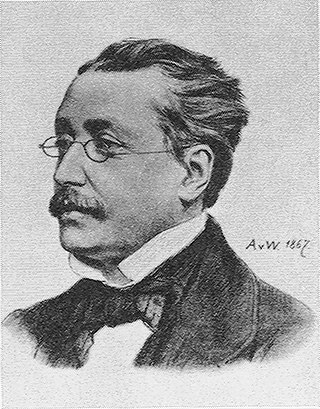
Joseph Victor von Scheffel was a German poet and novelist. His novel Ekkehard (1855) became one of the most popular German novels in the 19th century.

Waltharius is a Latin epic poem founded on German popular tradition relating the exploits of the Visigothic hero Walter of Aquitaine. While its subject matter is taken from early medieval Germanic legend, the epic stands firmly in the Latin literary tradition in terms of its form and the stylistic devices used. Thus, its 1456 verses are written in dactylic hexameter and the poem includes copious references to various Latin epics of antiquity, especially Vergil's Aeneid.

Tegernsee Abbey is a former Benedictine monastery in the town and district of Tegernsee in Bavaria. Both the abbey and the town that grew up around it are named after the Tegernsee, the lake on the shores of which they are located. The name is from the Old High German tegarin seo, meaning great lake.
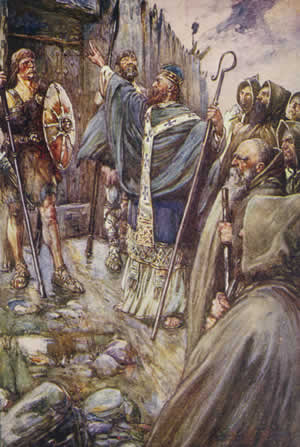
The Hiberno-Scottish mission was a series of expeditions in the 6th and 7th centuries by Gaelic missionaries originating from Ireland that spread Celtic Christianity in Scotland, Wales, England and Merovingian France. Catholic Christianity spread first within Ireland. Since the 8th and 9th centuries, these early missions were called 'Celtic Christianity'.

Solomon III was the Bishop of Constance from 890 to his death. In 885, the Emperor Charles III made him archchancellor of the Empire, for Konstanz was then the greatest diocese in Swabia, which had been Charles' original kingdom and was still his home most of the time. As well as bishop, he was also abbot of Reichenau and Saint Gall, immensely powerful abbeys in Swabia. Solomon founded a church in honour of Saint Magnus at Saint Gall.
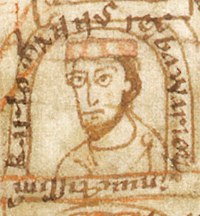
Notker Labeo, also known as Notker the German or Notker III, was a Benedictine monk active as a scholar and teacher. He was the first commentator on Aristotle active in the Middle Ages and translated the works of earlier Latin writers such as Boethius and Martianus Capella. Notker is also attributed the authorship of five short essays on music.
Ekkehard IV was a monk of the Abbey of Saint Gall and the author of the Casus sancti Galli and Liber Benedictionum.
Ekkehard is a German given name. It is composed of the elements ekke "edge, blade; sword" and hart "brave; hardy". Variant forms include Eckard, Eckhard, Eckhart, Eckart. The Anglo-Saxon form of the name was Ecgheard, possibly attested in the toponym Eggerton.
Notker Physicus was a monk at the Abbey of Saint Gall, active as a physician, painter, composer and poet. He is best known for his medical prowess, and may have been physician to the Holy Roman Emperors Otto I and Otto II.

The Abbey of Saint Maurice, Agaunum is a Swiss monastery of canons regular in Saint-Maurice, Canton of Valais, which dates from the 6th century. It is situated against a cliff in a section of the road between Geneva and the Simplon Pass. The abbey itself is a territorial abbacy and not part of any diocese. It is best known for its connection to the martyrdom of the Theban Legion, its original practice of perpetual psalmody, and a collection of art and antiquity.

Tuotilo was a Frankish monk at the Abbey of Saint Gall. He was a composer, and according to Ekkehard IV a century later, also a poet, musician, painter and sculptor. Various trope melodies can be assigned to Tuotilo, but works of other mediums are attributed with less certainty. He was a student of Iso of St. Gallen and friends with the fellow monk Notker the Stammerer.
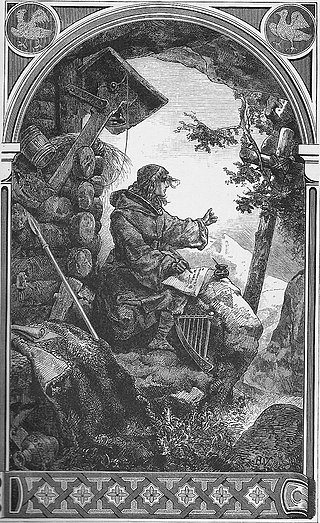
Ekkehard I, called Major or Senex, was a monk of the Abbey of Saint Gall. He was of noble birth, of the Jonschwyl family in Toggenburg, and was educated in the monastery of St. Gall; after joining the Benedictine Order, he was appointed director of the inner school there. Later, under Abbot Kralo, who trusted him implicitly, he was elected dean of the monastery, and for a while directed all the affairs of the abbey.
Ekkehard III was a monk of the Abbey of Saint Gall and a nephew of Ekkehard I and a cousin of Ekkehard II. He shared the educational advantages of his cousin and, at his invitation, accompanied him to Hohentwiel to superintend and direct the studies of the local clergy. On his return to St. Gall he was made dean of the abbey, and is reported to have filled this office for thirty years. He died early in the eleventh century.
Ekkehard V, called Minimus, was a monk of the Abbey of Saint Gall. He is the last of the Saint Gall Ekkehards, and flourished towards the end of the twelfth, and the beginning of the thirteenth, century. No particulars are known concerning his life, and tradition is silent as to his origin, the year of his birth and of his death. He was dean of the abbey in the reign of Innocent III.
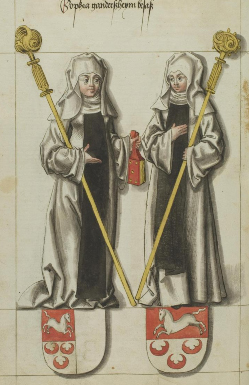
Sophia I, a member of the royal Ottonian dynasty, was Abbess of Gandersheim from 1002, and from 1011 also Abbess of Essen. The daughter of Emperor Otto II and his consort Theophanu, she was an important kingmaker in medieval Germany.
Ekkehard is an 1855 historical novel by the German writer Joseph Victor von Scheffel.